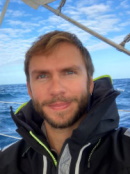Erwan Saulnier
Scientific Team

Miscellaneous Information
Background & Qualifications
I am a fisheries ecologist with a broad interest in marine population and community dynamics. Much of my work has focused on spatio-temporal patterns and drivers of demersal fish abundance, with an emphasis on essential fish habitats (nursery and spawning grounds) and predator-prey relationships.
After earning a M.Sc. in Fisheries and Aquatic Sciences from the Institut Agro (Rennes, France) in 2014, I worked for several months as a fisheries observer in the Indian Ocean. I completed my Ph.D. at the Institut Agro in 2019, where I studied the density-dependent processes that regulate the abundance of juvenile demersal fish in coastal and estuarine nurseries. I then worked as a Postdoctoral Researcher at the Fisheries Ecology and Modelling Lab (Ifremer, Nantes, France), focusing on interspecific synchrony among marine fishes in the Bay of Biscay. I completed a second Postdoctoral fellowship at the Fisheries Technology and Biology Lab (Ifremer, Lorient, France), where I conducted research on reef fish spawning aggregations using Remote Underwater Video (RUV) systems deployed in New Caledonia. In September 2024, I joined the Falkland Islands Fisheries Department as a Stock Assessment Scientist to work on the MSC-certified Patagonian toothfish longline fishery.
Further information: ORCID | ResearchGate | Google scholar
Research Interests
Quantitative marine ecology, Fisheries science and management, Conservation Biology, Statistical modelling, Population dynamics, Essential fish habitats, Predator-prey interactions, Climate and environmental drivers of marine populations, Demersal fish, Macrofauna
Publications
Saulnier E., Breckwoldt A., Robert M., and D. Pelletier. 2025. Remote underwater video for monitoring reef fish spawning aggregations. ICES Journal of Marine Science. 82: fsae194. https://doi.org/10.1093/icesjms/fsae194
Saulnier, E., and D. Pelletier. 2024. Reproductive behavior of blacksaddled coralgrouper (Plectropomus laevis) at a spawning aggregation site in New Caledonia. Ifremer. https://doi.org/10.24351/101975
Saulnier, E., A. Brind’Amour, J.B. Lecomte, E. Piette-Semeril, and V. M. Trenkel. 2023. Temporal synchrony among juvenile marine fishes and potential climate and environmental drivers in the Bay of Biscay. Progress in Oceanography. 211: 102969. https://doi.org/10.1016/j.pocean.2023.102969
Saulnier, E., H. Le Bris, A. Tableau, J.-C. Dauvin, and A. Brind’Amour. 2020. Food limitation of juvenile marine fish in a coastal and estuarine nursery. Estuarine, Coastal and Shelf Science. 241: 106670. https://doi.org/10.1016/j.ecss.2020.106670
Day, L., H. Le Bris, E. Saulnier, L. Pinsivy, and A. Brind’Amour. 2020. Benthic prey production index estimated from trawl survey supports the food limitation hypothesis in coastal fish nurseries. Estuarine, Coastal and Shelf Science. 235: 106594. https://doi.org/10.1016/j.ecss.2020.106594
Saulnier, E., A. Brind’Amour, A. Tableau, M. M. Rufino, J.-C. Dauvin, C. Luczak, and H. Le Bris. 2019. Seasonality in coastal macrobenthic biomass and its implications for estimating secondary production using empirical models. Limnology and Oceanography. 64: 935–949. https://doi.org/10.1002/lno.11086
Tableau, A., H. Le Bris, E. Saulnier, O. Le Pape, and A. Brind’Amour. 2019. Novel approach for testing the food limitation hypothesis in estuarine and coastal fish nurseries. Marine Ecology Progress Series. 629: 117–131. https://doi.org/10.3354/meps13090
